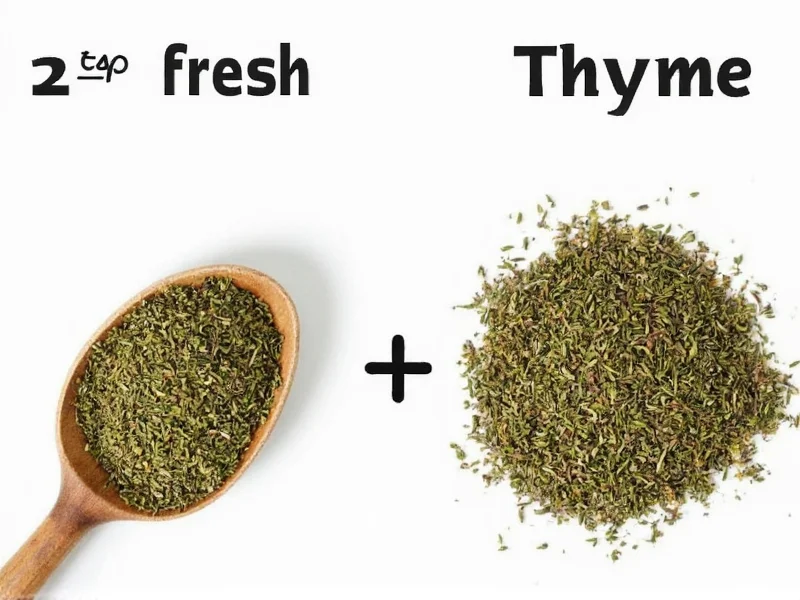When adapting recipes that call for fresh thyme but you only have dried thyme available, understanding the proper conversion ratio is essential for achieving balanced flavors in your dishes. The 3:1 ratio—where dried herbs are three times more potent than their fresh counterparts—is a fundamental principle in culinary measurement that applies perfectly to thyme.
The Science Behind Thyme Conversion Ratios
Thyme, like most culinary herbs, undergoes significant chemical changes during the drying process. Fresh thyme contains approximately 85% water content, which evaporates when dried, concentrating the essential oils and flavor compounds. This concentration explains why you need less dried thyme to achieve equivalent flavor intensity.
Chef Marco Rodriguez, a culinary instructor with 15 years of professional cooking experience, explains: The volatile oils that give thyme its distinctive aroma and flavor become more concentrated as moisture leaves the leaves. This is why the 3:1 ratio works consistently across most cooking applications.
Thyme Conversion Reference Guide
| Measurement | Fresh Thyme | Dried Thyme |
|---|---|---|
| Teaspoons | 1 tsp | 1/3 tsp |
| Teaspoons | 2 tsp | 2/3 tsp |
| Tablespoons | 1 tbsp | 1 tsp |
| Cups | 1 cup | 1/3 cup |
Practical Application in Recipe Development
When substituting dried thyme for fresh in your cooking, consider these practical tips for optimal results:
- Add dried herbs earlier in the cooking process to allow time for rehydration and flavor release
- Taste and adjust near the end of cooking, as individual dried thyme quality can vary
- Crumble dried thyme between your fingers before adding to release maximum flavor
- Store dried thyme properly in airtight containers away from light to maintain potency
Professional chefs often recommend starting with the standard 3:1 ratio but adjusting based on the specific dish. For delicate sauces or dressings, some prefer a slightly more conservative 2.5:1 ratio to prevent overpowering other flavors. In heartier dishes like stews or braises that cook for extended periods, the full 3:1 ratio typically works perfectly as some flavor dissipates during long cooking times.
Why Thyme Conversion Differs From Other Herbs
While the 3:1 ratio serves as a reliable guideline for most herbs, thyme has some unique characteristics worth noting. Unlike basil or cilantro which lose significant flavor complexity when dried, thyme actually improves in certain applications when dried. The drying process concentrates thyme's thymol content—the compound responsible for its distinctive earthy, slightly minty flavor—which makes dried thyme particularly well-suited for long-cooking dishes.
Food scientist Dr. Elena Martinez notes: Thyme is one of the few herbs where the dried version maintains excellent flavor integrity. Its essential oil composition remains stable during drying, unlike more delicate herbs like parsley or dill which lose significant volatile compounds.
Measuring Techniques for Precision
Accurate measurement makes the difference between a perfectly seasoned dish and one that's overpowering. When measuring dried thyme:
- Use proper measuring spoons rather than estimating
- For 2/3 teaspoon (the equivalent of 2 tsp fresh), fill a 1/2 teaspoon measure completely and add half of a 1/4 teaspoon measure
- Never pack dried thyme tightly—it should be lightly spooned into the measure
- Consider using a digital kitchen scale for critical recipes (1 gram dried thyme ≈ 3 grams fresh)
Remember that the age of your dried thyme affects potency. Dried thyme stored properly maintains good flavor for 1-2 years, but gradually loses potency. If your dried thyme has been in the pantry for more than 18 months, you might need to increase the amount slightly beyond the standard conversion.
Common Thyme Substitution Scenarios
Understanding fresh-to-dried thyme conversion becomes particularly valuable in these common cooking situations:
- Winter cooking when fresh herbs aren't readily available
- Meal prepping where dried herbs offer longer shelf stability
- Canning and preserving where dried herbs maintain flavor better
- International recipes that may specify fresh herbs uncommon in your region
When adapting family recipes that have always used fresh thyme, start with the standard conversion but trust your palate—taste as you cook and adjust if needed. The beauty of cooking is that while measurements provide guidance, personal preference ultimately determines the perfect seasoning for your dish.











 浙公网安备
33010002000092号
浙公网安备
33010002000092号 浙B2-20120091-4
浙B2-20120091-4